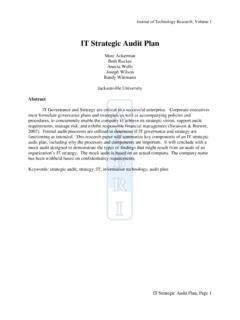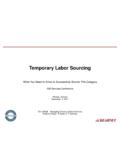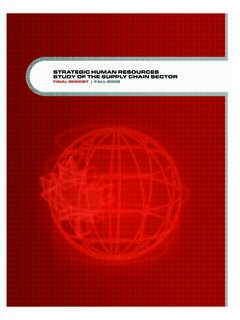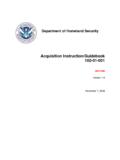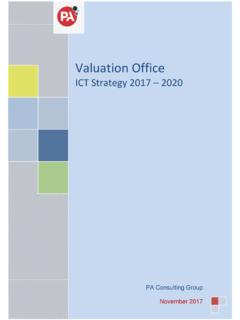Transcription of : The Strategic Transformation ITC Limited - …
1 Page 1 of 21 ITC Limited : The Strategic Transformation A Case Study Sometimes, not taking a risk is the biggest risk - Padma Bhushan Yogesh C. Deveshwar 1. Background ITC Limited is adiversified Indian conglomerate headquartered in Kolkata that has a meaningful presence in all the three sectors of the national economy -agriculture, services and manufacturing. With significant interests in the Fast-Moving Consumer Goods (FMCG), Hotels, Paperboards & Packaging, Agri Business & Information Technology sectors, the company presently employs over 31,000 people across India. During FY 2016, ITC clocked annual revenues of US$ billion and enjoyed a market capitalization of US$45 billion. ITC is rooted in the philosophy of congruence of business and social purpose. The company is engaged in continuously refining business models that support competitiveness across the larger value chain. At the turn of the millennium, ITC redefined its corporate vision to put sustainability and inclusive growth at the top of its agenda.
2 Supported by the bedrock of solid financial performance, the company crafted innovative business models that generated sustainable livelihood opportunities and simultaneously helped to renew ecological resources. To foster sustainable and inclusive growth, ITC has spearheaded an Integrated Rural Development Program with four distinct objectives: (i) the dissemination of information and knowledge (ii) access to quality inputs and markets (iii) generating supplementary incomes, and (iv) the augmentation of natural resources This intervention has enabled a comprehensive development of the rural ecosystem, empowered farmers and raised rural incomes. To address the challenges of environmental degradation, ITC constantly strives to minimize its environmental impact from leading-edge manufacturing processes in its factories to building the largest, greenest hotels in India, and making it a priority to clean up the eco-footprint of all aspects of its operations as far as possible as well as expanding its renewable energy portfolio.
3 ITC is today the only company in world to be carbon positive, water positive, and solid waste recycling positive. Almost 47% of the energy consumed across ITC is from renewable sources. Page 2 of 21 2. The Genesis of the Institution ITC Limited s parent organization British American Tobacco (BAT) owes its origins to Mr. James Buchanan Buck Duke, who was in charge of a granulated tobacco factory in the United States in 1881. Buck Duke invested early into cigarette machinery, and his company captured 38% share of the US cigarette market by 1889. He then facilitated the amalgamation of four other companies with his own to form the American Tobacco Company (ATC). Soon thereafter, ATC acquired a foothold in the British market. To counter the impending threat of competition, & Wills gathered all the major tobacco businesses in Britain to form the Imperial Tobacco Company (of Great Britain and Ireland). This consolidation led to intense competition and internecine price wars in both the US and the UK markets.
4 Dwindling profits finally brought the two companies to the negotiation table. In September 1902, the two giants eventually consented to pull out from each other s home markets. They also jointly established the British American Tobacco (BAT) Company in an effort to establish a presence and trade their products in territories outside of the US and UK. At that time, these two partners in BAT held separate interests with respect to the manufacturing and selling of cigarettes in India, as also the purchasing of tobacco leaf. The American Tobacco Company had invested into a cigarette manufacturing facility at Munger in 1907 through Peninsular Tobacco, while the Imperial Tobacco Company was selling branded cigarettes in India through Dominion Tobacco and other companies. The presence of British American Tobacco (BAT) in India was formally established in 1906when two of its employees (Jellicoe and Page) landed in the country in search of an agent to distribute their Wills and Scissors brand of cigarettes.
5 The duo began to educate people on the pleasures of smoking cigarettes , and advertised their products through moving musical trucks. Sales soared very soon, and an extensive distribution network came into being. The Imperial Tobacco Company of India came into being in August 1910 when the British American Tobacco (BAT) decided to set up a full-fledged sales operation in the country. To cope with the growing demand, BAT set up another cigarette manufacturing unit in Bangalore in 1912. In July 1912, BAT also established the Indian Leaf Tobacco Company (ILTC) to focus upon the local sourcing and processing of tobacco. To meet with the packaging and printing requirements of the cigarette business, BAT set up a packaging and printing facility in 1925. In 1939, ITC invested in duplex board while it entered the paper business in 1944. By the time ITC moved its headquarters to Virginia House in Kolkata in 1928, it was managing the entire gamut of BAT s operations in India- consolidated under a single umbrella.
6 Page 3 of 21 The Post-Independence Era The years after Indian independence were rather challenging for the company. The Government of India levied excise duty on cigarettes in 1948, and the states levied other taxes. Taxation soon became the single largest component of the cost of cigarettes in the country. In order to sustain profits, the Imperial Tobacco Company raised the prices. As a result, the company s brands lost market share to local rivals such as Golden Tobacco and National Tobacco. Between 1947 and 1961, ITC s market share slipped from over 70%to below 40%. Meanwhile, ITC began to reduce the number of expatriates on its rolls. Abdul Rub Sardar Hussain became the first person to be inducted as a covenanted Indian Assistant in September 1934. By 1947, there were 121 Indian managers comprising 44 % of the management cadre of ITC. Tonny Drayton was ITC s last expatriate to leave for home shores- in September 1979.
7 Post-independence, ITC continued to invest in all the complementary businesses associated with cigarettes in India. In 1954, it entered the aluminium foils business. The company commenced the manufacture of cigarette making machinery in 1960, entered the fibreboard containers business in 1963, and began to manufacture cigarette filter rods in 1969. That was also the year in which ITC appointed Mr. Ajit Narain Haksar as its Chairman. The company then began a journey that would make it a rare business enterprise with significant foreign ownership that wedded its own developmental goals with those of its host country. The AN Haksar Era (1969 - 1983) Born at Gwalior in 1925, Mr. Ajit Narain Haksar joined the Imperial Tobacco Company of India as a management pupil in with a faith in market research that was acquired during his MBA at the Harvard Business School, he institutionalized the marketing function at ITC. Mr. Haksar was appointed as ITC s Marketing Director in 1966 and Deputy Chairman in 1968, before being appointed as the company s Chairman in September1969.
8 Prior to accepting the responsibility, he is reputed to have asked the following three questions of the BAT senior management: a) Which comes first your company or my country? b) Who runs the Company - BAT, or the Chairman and the Board of Directors in India? c) Will ITC be required to do what BAT wants, or what its Chairman and the Board of Directors in India consider to be more appropriate investments with relevance to India? Upon receiving suitable answers that helped to clear his conscience, he consented to become the first Indian to be placed at the helm of that flabby, foreign-owned organization with a colonial Page 4 of 21 mindset. Valuing style over substance, the company was struggling to maintain its market share. To his credit, Mr. Haksar led ITC s metamorphosis into an aggressive, outward-looking corporation that was quick to spot and capitalize upon emerging opportunities. In the early seventies, a strong nationalist undercurrent swept India.
9 It resulted in much turbulence in the economic, political and regulatory environment of the country. Taking advantage of the prevailing sentiment, Golden Tobacco launched a tirade against ITC that sought to position the latter as a foreign enterprise that endangered indigenous firms. The company responded by changing its name to Ltd in 1974, in order to symbolize the move beyond tobacco. It also drew up plans to enter the core industry sectors where the Government found it difficult to attract investment by big industrial undertakings. After careful deliberation, ITC decided to diversify into Hotels, Paperboards and Marine Foods. While paperboards had linkages to the cigarette business, hotels and marine foods were potential foreign exchange earners. Being employment-intensive, the hotel business served the larger social needs of the country even as it utilized the company s marketing expertise and consumer service skills in an industry environment where the competition was nearly absent.
10 However, the parent company held strong reservations about ITC s ability to manage its diversification forays. For instance, when AN Haksar and his deputy Ramesh Sarin presented the plans for a paper mill to BAT, they were dissuaded from the endeavor. Nevertheless, ITC persisted in its endeavour. In July 1979, Sarin wrote the following lines to BAT in London: This letter is written on the first sheet of paper produced at Bhadrachalam Paperboards Limited (BPL). It is not indicative of quality, but it does signify human endeavor and enterprise. The project has been completed before time, and within the agreed budgeted cost. The diversification of ITC s businesses was largely successful, except for marine foods. The company managed to hold on to its leadership in tobacco, while its hotels division quickly outstripped much older rival chains. The move into paperboard broke new ground in an area where no one had cared to invest for a decade.



